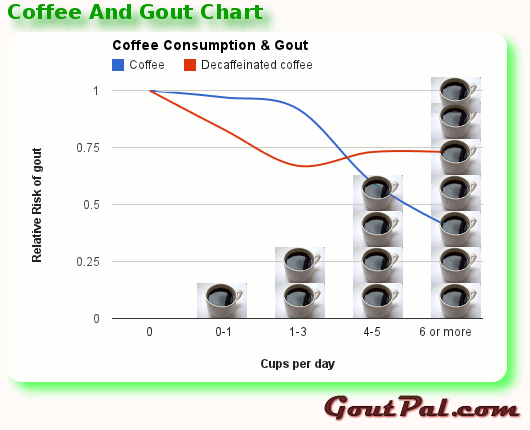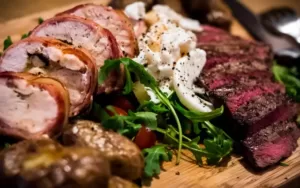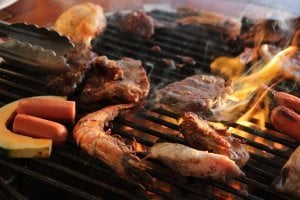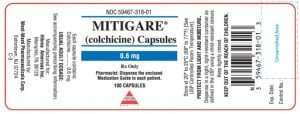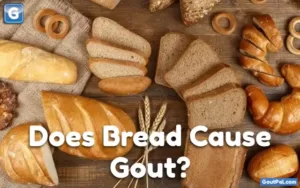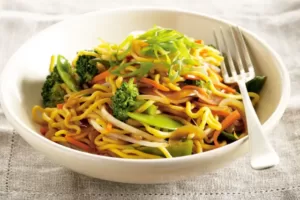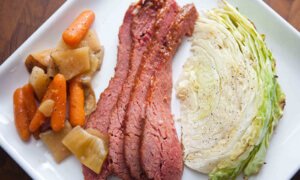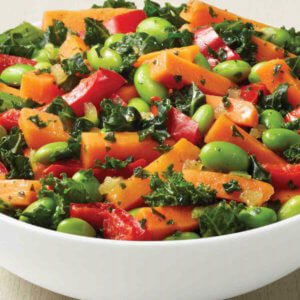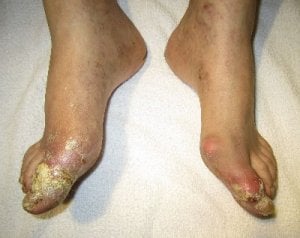This is a review of a study Coffee And Gout. It is one of the articles relating to Gout Diet Foods To Eat.
About This Coffee And Gout Report
I have extracted the main ideas from the published gout investigation to present these in a more readable format suitable for unqualified gout sufferers. Inevitably, such scientific reporting will still include technical references. I will refer to my gout glossary for more explanation. If you encounter a term you do not understand, you should search for it using the search box above. If that does not provide an adequate explanation, then please ask in the gout forums.
Coffee And Gout Report Abstract
This is a layman’s summary of:
- Title
- Coffee Consumption and Risk of Incident Gout in Men
- Authors
- Choi HK, Willett W, Curhan G.
- Published
- Arthritis Rheum. 2007 Jun;56(6):2049-55.
Objective
Coffee is one of the most widely consumed beverages in the world and may affect the risk of gout via various mechanisms. We prospectively evaluated the relationship between coffee intake and the risk of incident gout in a large cohort of men.
Methods
Over a 12-year period, we studied 45,869 men with no history of gout at baseline. Intake of coffee, decaffeinated coffee, tea, and total caffeine was assessed every 4 years through validated questionnaires. We used a supplementary questionnaire to ascertain whether participants met the American College of Rheumatology survey criteria for gout.
Results
We documented 757 confirmed incident cases of gout. Increasing coffee intake was associated with a decreasing risk of gout. The relative risks for gout were compared in multiple coffee consumption categories:
| Cups per day | 0 | 0-1 | 1-3 | 4-5 | 6 or more |
|---|---|---|---|---|---|
| Coffee | 1.00 | 0.97 | 0.92 | 0.60 | 0.41 |
| Decaffeinated coffee | 1.00 | 0.83 | 0.67 | 0.73 (4 or more) | |
Total caffeine from all sources and tea intake were not associated with the risk of gout.
Conclusion
These prospective data suggest that long-term coffee consumption is associated with a lower risk of incident gout.
Coffee And Gout Report
Background
The report starts with explanation of the prevalence of gout[1-5], and the suggestion that coffee may be associated with uric acid in the blood[6], and insulin resistance[7-14]. Given the prevalence of coffee consumption, around 2 cups per day on average for American citizens[14-15], this is an important issue.
The report includes several references to possible reasons why coffee may be associated with gout[16-29]. It highlights other studies that report associations between coffee and gout[6][30].
Study Design
The study uses data from a health professionals survey giving over forty-five thousand respondents who did not have gout at the start of the process. Various aspects of diet were monitored[31-34], and participants reporting incidences of gout[35] were extracted.
The report describes details of statistical analysis techniques used, referring to several studies, including two statistical dietary analyses[36-37].
Results
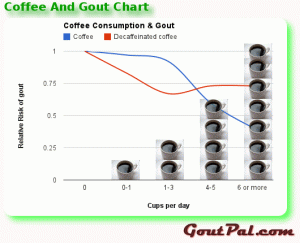
The full report includes more details about results and data obtained, but the key figures are summarized neatly in the chart, which uses the same data as shown in the abstract above.
Discussion
The report closes with a review of related studies[38-56],and concludes:
Our study was observational; thus, we cannot rule out the possibility that unmeasured factors might contribute to the observed associations. Overall, however, our findings provide prospective evidence that long-term coffee consumption is associated with a lower risk of gout.
Coffee And Gout: Next Steps
You can now see that coffee consumption seems to be good for gout. What we really need is actual case studies on gout patients with accurate comparisons on different fluids. One glaring omission from this report is any comparison with plain water. The other possibility is the effect of milk, which is often taken in coffee – search for milk in the box near the top of the page if you have not yet discovered the uric acid lowering potential in dairy proteins.
Leave Coffee And Gout to browse Gout Diet Foods To Eat.
Coffee And Gout Related Topics
Please remember: to find more related pages that are relevant to you, use the search box near the top of every page.
Common Terms: caffeine, coffee, Gout Diet List Of Foods To Eat
Other posts that include these terms:
- Coffee and Uric Acid
- Greek Yogurt and Gout with tasty secret recipe
- Gout Diet Foods To Eat
- Gout Diet Foods To Eat: Theobromine and Gout
- Coffee And Gout – Great Gouty Arthritis Drinks
- Best Home Remedies For Gout: Water
Coffee And Gout References
| Title | Author(s) | Published | Link |
|---|---|---|---|
| Incidence and risk factors for gout in white men. | Roubenoff R, Klag MJ, Mead LA, Liang KY, Seidler AJ, Hochberg MC. | JAMA 1991; 266: 3004–7. | |
| Purine-rich foods, dairy and protein intake, and the risk of gout in men. | Choi HK, Atkinson K, Karlson EW, Willett WC, Curhan G. | New Engl J Med 2004; 350: 1093–103. | |
| Alcohol intake and risk of incident gout in men: a prospective study. | Choi HK, Atkinson K, Karlson EW, Willett WC, Curhan G. | Lancet 2004; 363: 1277–81. | |
| Obesity, weight change, hypertension, diuretic use, and risk of gout in men: the health professionals follow-up study. | Choi HK, Atkinson K, Karlson EW, Curhan G. | Arch Intern Med 2005; 165: 742–8. | Obesity And Gout |
| Pathogenesis of gout. | Choi HK, Mount DB, Reginato AM. | Ann Intern Med 2005; 143: 499–516. | |
| Inverse association between coffee drinking and serum uric acid concentrations in middle-aged Japanese males. | Kiyohara C, Kono S, Honjo S, Todoroki I, Sakurai Y, Nishiwaki M, et al. | Br J Nutr 1999; 82: 125–30. | |
| Caffeine ingestion increases the insulin response to an oral-glucose-tolerance test in obese men before and after weight loss. | Petrie HJ, Chown SE, Belfie LM, Duncan AM, McLaren DH, Conquer JA, et al. | Am J Clin Nutr 2004; 80: 22–8. | |
| Caffeine ingestion decreases glucose disposal during a hyperinsulinemic-euglycemic clamp in sedentary humans. | Greer F, Hudson R, Ross R, Graham T. | Diabetes 2001; 50: 2349–54. | |
| Caffeine can decrease insulin sensitivity in humans. | Keijzers GB, De Galan BE, Tack CJ, Smits P. | Diabetes Care 2002; 25: 364–9. | |
| Caffeine-induced impairment of insulin action but not insulin signaling in human skeletal muscle is reduced by exercise. | Thong FS, Derave W, Kiens B, Graham TE, Urso B, Wojtaszewski JF, et al. | Diabetes 2002; 51: 583–90. | |
| Caffeine-induced impairment of glucose tolerance is abolished by ?-adrenergic receptor blockade in humans. | Thong FS, Graham TE. | J Appl Physiol 2002; 92: 2347–52. | |
| Caffeinated coffee, decaffeinated coffee, and caffeine in relation to plasma C-peptide levels, a marker of insulin secretion, in U.S. women. | Wu T, Willett WC, Hankinson SE, Giovannucci E. | Diabetes Care 2005; 28: 1390–6. | |
| Coffee consumption and risk of type 2 diabetes: a systematic review. | Van Dam RM, Hu FB. | JAMA 2005; 294: 97–104. | |
| Coffee consumption and risk for type 2 diabetes mellitus. | Salazar-Martinez E, Willett WC, Ascherio A, Manson JE, Leitzmann MF, Stampfer MJ, et al. | Ann Intern Med 2004; 140: 1–8. | |
| Caffeine consumption. In: SpillerGA, editor. | Lundsberg LS. | Caffeine. Boca Raton (FL): CRC Press; 1998. p. 199–224. | |
| Inhibitory effects of methylxanthines on the activity of xanthine oxidase. | Kela U, Vijayvargiya R, Trivedi CP. | Life Sci 1980; 27: 2109–19. | |
| Normal caffeine consumption: influence on thermogenesis and daily energy expenditure in lean and postobese human volunteers. | Dulloo AG, Geissler CA, Horton T, Collins A, Miller DS. | Am J Clin Nutr 1989; 49: 44–50. | |
| Caffeine: a double-blind, placebo-controlled study of its thermogenic, metabolic, and cardiovascular effects in healthy volunteers. | Astrup A, Toubro S, Cannon S, Hein P, Breum L, Madsen J. | Am J Clin Nutr 1990; 51: 759–67. | |
| Effects of caffeine on energy metabolism, heart rate, and methylxanthine metabolism in lean and obese women. | Bracco D, Ferrarra JM, Arnaud MJ, Jequier E, Schutz Y. | Am J Physiol 1995; 269: 671–8. | |
| Tolerance to the humoral and hemodynamic effects of caffeine in man. | Robertson D, Wade D, Workman R, Woosley RL, Oates JA. | J Clin Invest 1981; 67: 1111–7. | |
| Coffee consumption and insulin sensitivity. | Arnlov J, Vessby B, Riserus U. | JAMA 2004; 291: 1199–201. | |
| Coffee consumption and risk of type 2 diabetes mellitus. | Van Dam RM, Feskens EJ. | Lancet 2002; 360: 1477–8. | |
| Coffee consumption and risk of type 2 diabetes mellitus among middle-aged Finnish men and women. | Tuomilehto J, Hu G, Bidel S, Lindstrom J, Jousilahti P. | JAMA 2004; 291: 1213–9. | |
| Uric acid and coronary heart disease risk: evidence for a role of uric acid in the obesity-insulin resistance syndrome. The Normative Aging Study. | Lee J, Sparrow D, Vokonas PS, Landsberg L, Weiss ST. | Am J Epidemiol 1995; 142: 288–94. | |
| Relations of hyperuricemia with the various components of the insulin resistance syndrome in young black and white adults: the CARDIA study. Coronary Artery Risk Development in Young Adults. | Rathmann W, Funkhouser E, Dyer AR, Roseman JM. | Ann Epidemiol 1998; 8: 250–61. | |
| Hyperlipidaemia in hyperuricaemia and gout. | Emmerson B. | Ann Rheum Dis 1998; 57: 509–10. | |
| Gout, diet, and the insulin resistance syndrome. | Fam AG. | J Rheumatol 2002; 29: 1350–5. | |
| Renal handling of urate and sodium during acute physiological hyperinsulinaemia in healthy subjects. | Ter Maaten JC, Voorburg A, Heine RJ, Ter Wee PM, Donker AJ, Gans RO. | Clin Sci (Lond) 1997; 92: 51–8. | |
| Effect of insulin on renal sodium and uric acid handling in essential hypertension. | Muscelli E, Natali A, Bianchi S, Bigazzi R, Galvan AQ, Sironi AM, et al. | Am J Hypertens 1996; 9: 746–52. | |
| Coffee, tea, and caffeine consumption and serum uric acid level: The Third National Health and Nutrition Examination Survey. | Choi HK, Curhan G. | Arthritis Rheum. In press. | |
| Reproducibility and validity of an expanded self-administered semiquantitative food frequency questionnaire among male health professionals. | Rimm EB, Giovannucci EL, Stampfer MJ, Colditz GA, Litin LB, Willett WC. | Am J Epidemiol 1992; 135: 1114–26. | |
| Reproducibility and validity of a semiquantitative food frequency questionnaire. | Willett WC, Sampson L, Stampfer MJ, Rosner B, Bain C, Witschi J, et al. | Am J Epidemiol 1985; 122: 51–65. | |
| Reproducibility and validity of food intake measurements from a semiquantitative food frequency questionnaire. | Feskanich D, Rimm EB, Giovannucci EL, Colditz GA, Stampfer MJ, Litin LB, et al. | J Am Diet Assoc 1993; 93: 790–6. | |
| A prospective study of the intake of vitamins C and B6, and the risk of kidney stones in men. | Curhan GC, Willett WC, Rimm EB, Stampfer MJ. | J Urol 1996; 155: 1847–51. | |
| Preliminary criteria for the classification of the acute arthritis of primary gout. | Wallace SL, Robinson H, Masi AT, Decker JL, McCarty DJ, Yu TF. | Arthritis Rheum 1977; 20: 895–900. | |
| Dietary fat intake and the risk of coronary heart disease in women. | Hu FB, Stampfer MJ, Manson JE, Rimm E, Colditz GA, Rosner BA, et al. | N Engl J Med 1997; 337: 1491–9. | |
| Dietary protein and risk of ischemic heart disease in women. | Hu FB, Stampfer MJ, Manson JE, Rimm E, Colditz GA, Speizer FE, et al. | Am J Clin Nutr 1999; 70: 221–7. | |
| Chlorogenic acid and hydroxynitrobenzaldehyde: new inhibitors of hepatic glucose 6-phosphatase. | Arion WJ, Canfield WK, Ramos FC, Schindler PW, Burger HJ, Hemmerle H, et al. | Arch Biochem Biophys 1997; 339: 315–22. | |
| Enhancement of glucose disposal in patients with type 2 diabetes by ?-lipoic acid. | Jacob S, Henriksen EJ, Schiemann AL, Simon I, Clancy DE, Tritschler HJ, et al. | Arzneimittelforschung 1995; 45: 872–4 | |
| Intramuscular heat shock protein 72 and heme oxygenase-1 mRNA are reduced in patients with type 2 diabetes: evidence that insulin resistance is associated with a disturbed antioxidant defense mechanism. | Bruce CR, Carey AL, Hawley JA, Febbraio MA. | Diabetes 2003; 52: 2338–45. | |
| Influence of ?-lipoic acid on lipid peroxidation and antioxidant defence system in blood of insulin-resistant rats. | Thirunavukkarasu V, Anuradha CV. | Diabetes Obes Metab 2004; 6: 200–7. | |
| Chlorogenic acid and other cinnamates – nature, occurrence, dietary burden, absorption and metabolism. | Clifford MN. | J Sci Food Agric 2000; 80: 1033–43. | |
| Coffee acutely modifies gastrointestinal hormone secretion and glucose tolerance in humans: glycemic effects of chlorogenic acid and caffeine. | Johnston KL, Clifford MN, Morgan LM. | Am J Clin Nutr 2003; 78: 728–33. | |
| Glucagon-like peptides. | Drucker DJ. | Diabetes 1998; 47: 159–69. | |
| Intakes of antioxidants in coffee, wine, and vegetables are correlated with plasma carotenoids in humans. | Svilaas A, Sakhi AK, Andersen LF, Svilaas T, Strom EC, Jacobs DR Jr, et al. | J Nutr 2004; 134: 562–7. | |
| Comparison of the antioxidant activity of commonly consumed polyphenolic beverages (coffee, cocoa, and tea) prepared per cup serving. | Richelle M, Tavazzi I, Offord E. | J Agric Food Chem 2001; 49: 3438–42. | |
| Total antioxidant capacity of plant foods, beverages and oils consumed in Italy assessed by three different in vitro assays. | Pellegrini N, Serafini M, Colombi B, Del Rio D, Salvatore S, Bianchi M, et al. | J Nutr 2003; 133: 2812–9. | |
| Caffeine and cigarette smoking: behavioral, cardiovascular, and metabolic interactions. | Brown CR, Benowitz NL. | Pharmacol Biochem Behav 1989; 34: 565–70. | |
| Asymptomatic hyperuricemia. Risks and consequences in the Normative Aging Study. | Campion EW, Glynn RJ, DeLabry LO. | Am J Med 1987; 82: 421–6. | |
| Effect of low level lead exposure on hyperuricemia and gout among middle aged and elderly men: the Normative Aging Study. | Shadick NA, Kim R, Weiss S, Liang MH, Sparrow D, Hu H. | J Rheumatol 2000; 27: 1708–12. | |
| Gout and coronary heart disease: the Framingham Study. | Abbott RD, Brand FN, Kannel WB, Castelli WP. | J Clin Epidemiol 1988; 41: 237–42. | |
| Racial differences in the incidence of gout: the role of hypertension. | Hochberg MC, Thomas J, Thomas DJ, Mead L, Levine DM, Klag MJ. | Arthritis Rheum 1995; 38: 628–32. | |
| A case-control study of alcohol consumption and drinking behaviour in patients with acute gout. | Sharpe CR. | Can Med Assoc J 1984; 131: 563–7. | |
| A controlled study of diet in patients with gout. | Gibson T, Rodgers AV, Simmonds HA, Court-Brown F, Todd E, Meilton V. | Ann Rheum Dis 1983; 42: 123–7. | |
| Effect of oestrogen therapy on plasma and urinary levels of uric acid. | Nicholls A, Snaith ML, Scott JT. | Br Med J 1973; 1: 449–51. | |
| The effect of acid loading on renal excretion of uric acid and ammonium in gout. | Gibson T, Hannan SF, Hatfield PJ, Simmonds HA, Cameron JS, Potter CS, et al. | Adv Exp Med Biol 1977; 76B: 46–56. |
Please give your feedback
Did this page help you? If yes, please consider a small donation. Your donations help keep GoutPal's gout support services free for everyone.
If not, please tell me how I can improve it to help you more.
- YouTube
- The gout forums.
